Macroeconomics Assignment: Analysis of Money, Interest, and Inflation
VerifiedAdded on 2023/03/31
|10
|1156
|381
Homework Assignment
AI Summary
This macroeconomics assignment delves into key concepts such as the quantity theory of money, inflation, and interest rates. It begins by examining an economy with a constant income velocity of money, analyzing the inflation rate and nominal interest rate based on given real GDP and money stock growth rates. The assignment then explores the impact of changes in the income velocity of money on these rates. It differentiates between transaction and income velocity of money, discussing their importance. Furthermore, it investigates the opportunity cost of holding real money balances and analyzes how changes in money supply, both immediate and anticipated, affect the price level, incorporating graphical representations to illustrate the effects on money market and aggregate demand. The assignment concludes with a detailed explanation of the central bank's role and its impact on the economy.
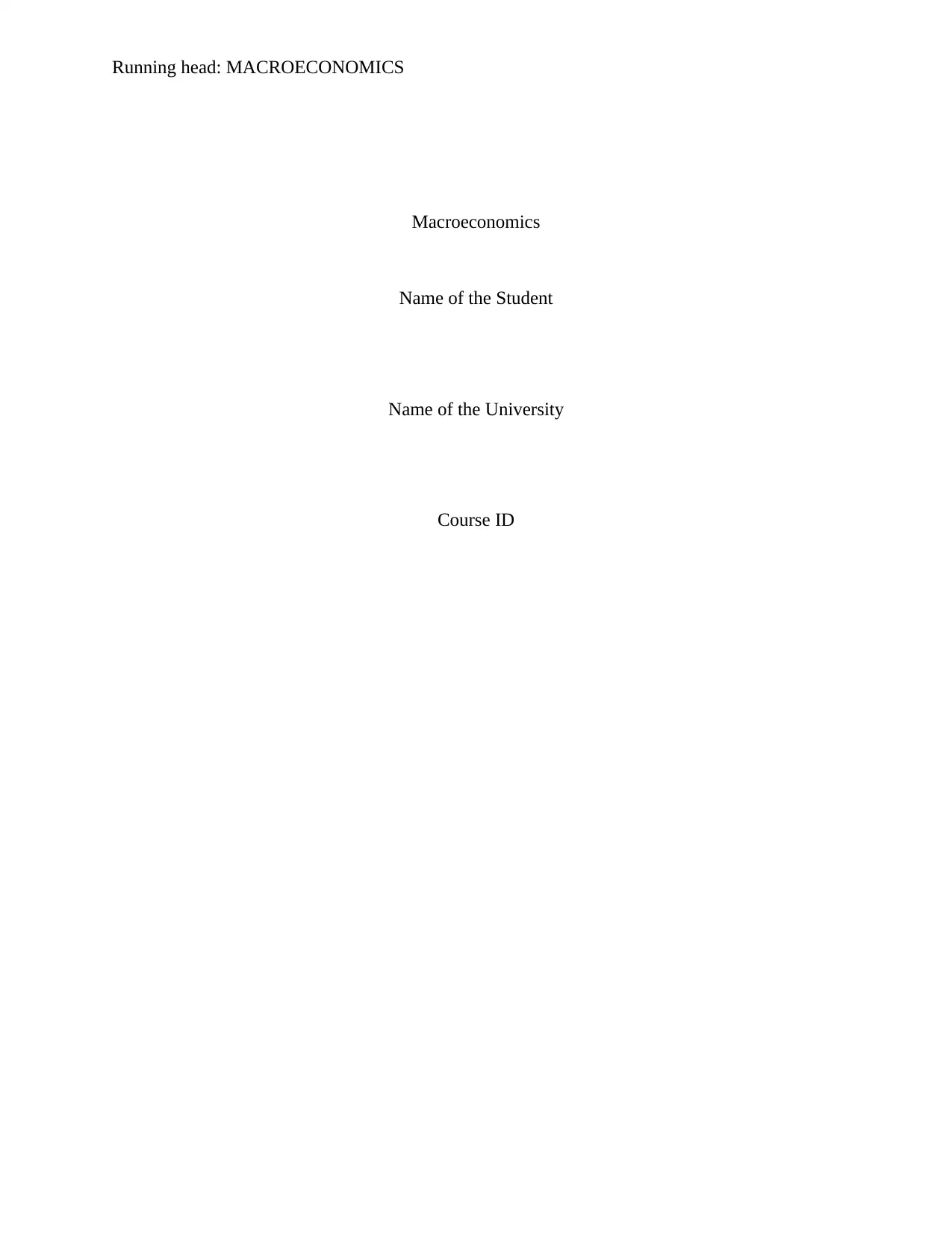
Running head: MACROECONOMICS
Macroeconomics
Name of the Student
Name of the University
Course ID
Macroeconomics
Name of the Student
Name of the University
Course ID
Paraphrase This Document
Need a fresh take? Get an instant paraphrase of this document with our AI Paraphraser
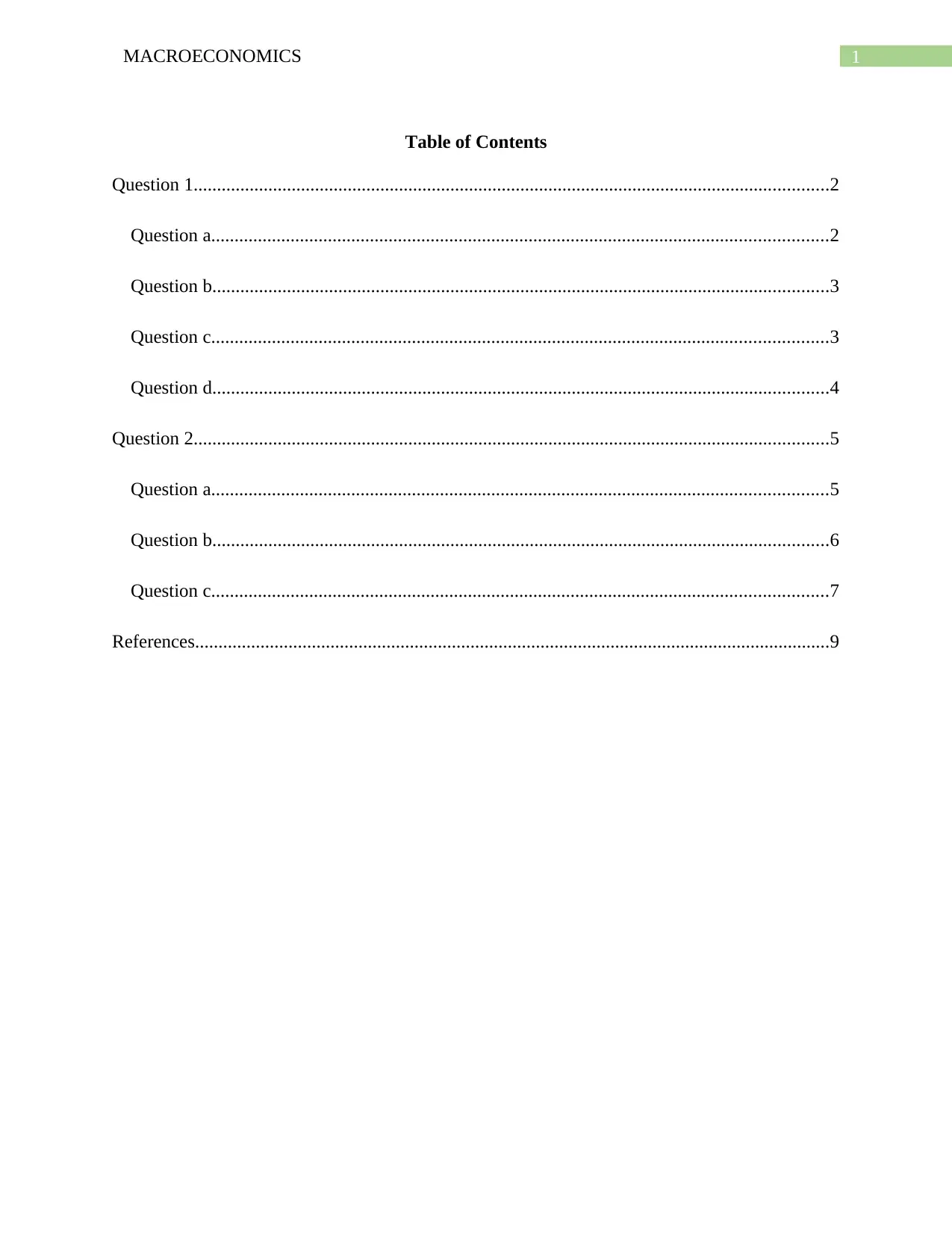
1MACROECONOMICS
Table of Contents
Question 1........................................................................................................................................2
Question a....................................................................................................................................2
Question b....................................................................................................................................3
Question c....................................................................................................................................3
Question d....................................................................................................................................4
Question 2........................................................................................................................................5
Question a....................................................................................................................................5
Question b....................................................................................................................................6
Question c....................................................................................................................................7
References........................................................................................................................................9
Table of Contents
Question 1........................................................................................................................................2
Question a....................................................................................................................................2
Question b....................................................................................................................................3
Question c....................................................................................................................................3
Question d....................................................................................................................................4
Question 2........................................................................................................................................5
Question a....................................................................................................................................5
Question b....................................................................................................................................6
Question c....................................................................................................................................7
References........................................................................................................................................9
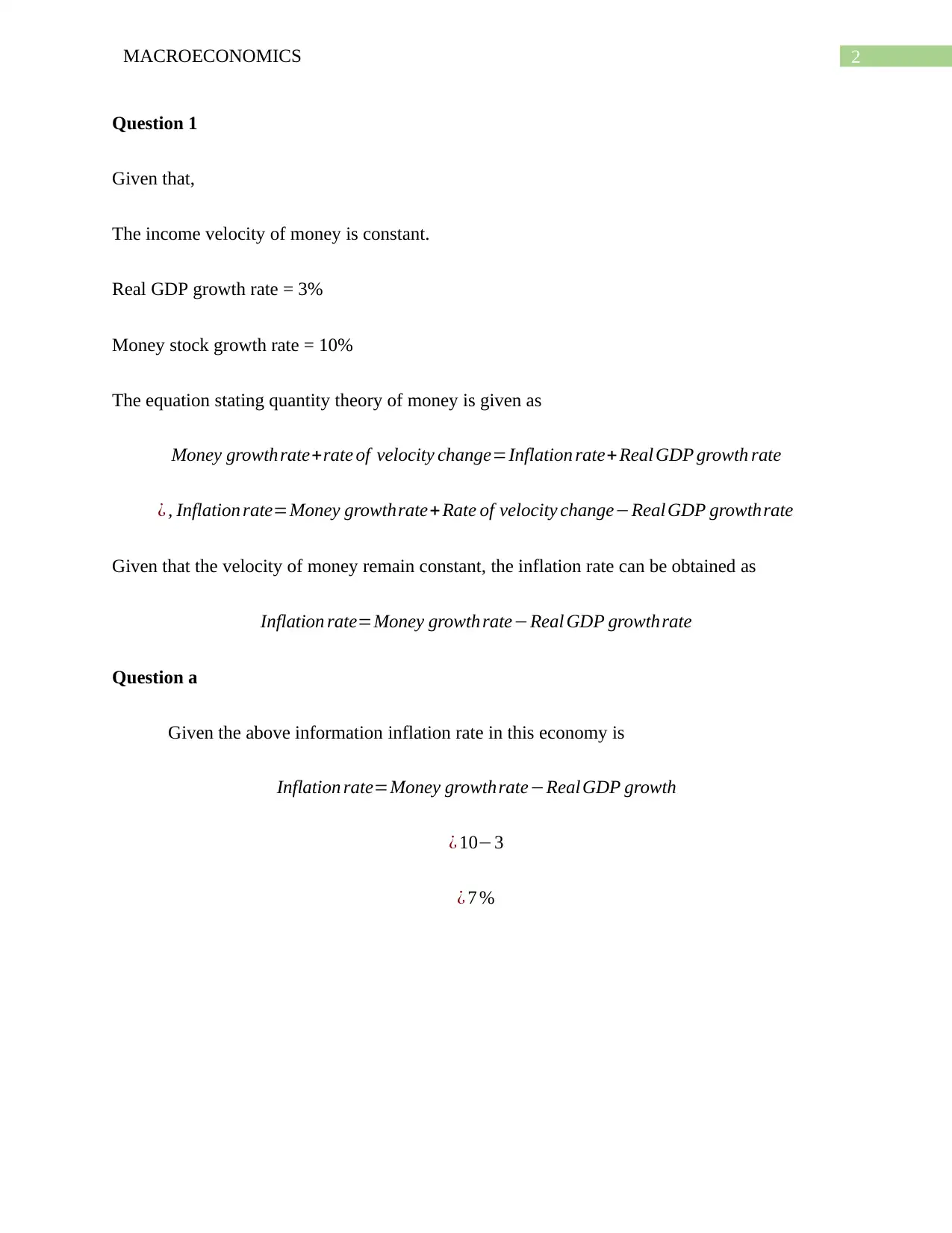
2MACROECONOMICS
Question 1
Given that,
The income velocity of money is constant.
Real GDP growth rate = 3%
Money stock growth rate = 10%
The equation stating quantity theory of money is given as
Money growthrate+rate of velocity change=Inflation rate+ Real GDP growth rate
¿ , Inflation rate=Money growthrate+ Rate of velocity change−Real GDP growthrate
Given that the velocity of money remain constant, the inflation rate can be obtained as
Inflation rate=Money growth rate−Real GDP growthrate
Question a
Given the above information inflation rate in this economy is
Inflation rate=Money growthrate−Real GDP growth
¿ 10−3
¿ 7 %
Question 1
Given that,
The income velocity of money is constant.
Real GDP growth rate = 3%
Money stock growth rate = 10%
The equation stating quantity theory of money is given as
Money growthrate+rate of velocity change=Inflation rate+ Real GDP growth rate
¿ , Inflation rate=Money growthrate+ Rate of velocity change−Real GDP growthrate
Given that the velocity of money remain constant, the inflation rate can be obtained as
Inflation rate=Money growth rate−Real GDP growthrate
Question a
Given the above information inflation rate in this economy is
Inflation rate=Money growthrate−Real GDP growth
¿ 10−3
¿ 7 %
⊘ This is a preview!⊘
Do you want full access?
Subscribe today to unlock all pages.

Trusted by 1+ million students worldwide
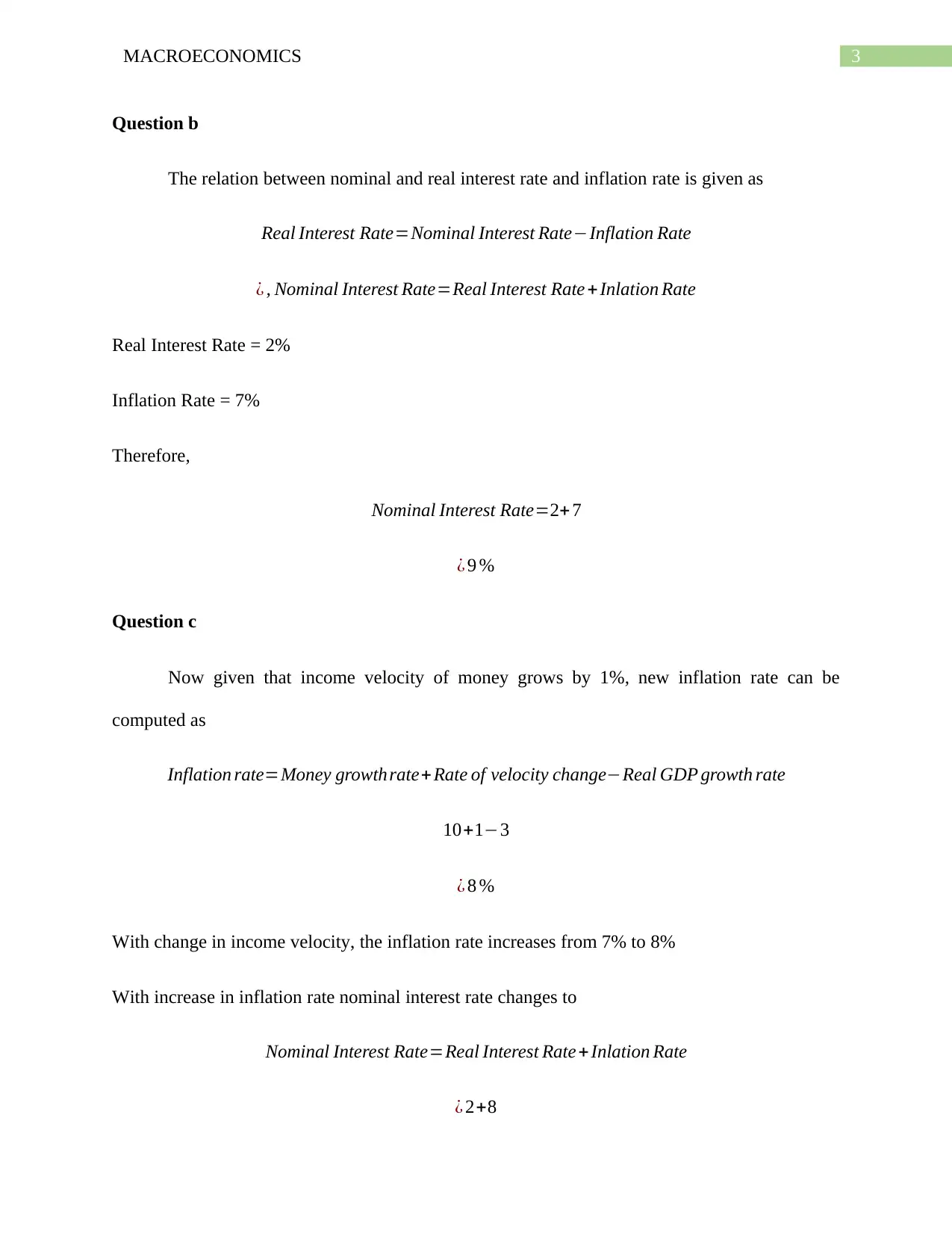
3MACROECONOMICS
Question b
The relation between nominal and real interest rate and inflation rate is given as
Real Interest Rate=Nominal Interest Rate−Inflation Rate
¿ , Nominal Interest Rate=Real Interest Rate + Inlation Rate
Real Interest Rate = 2%
Inflation Rate = 7%
Therefore,
Nominal Interest Rate=2+ 7
¿ 9 %
Question c
Now given that income velocity of money grows by 1%, new inflation rate can be
computed as
Inflation rate=Money growth rate+ Rate of velocity change−Real GDP growth rate
10+1−3
¿ 8 %
With change in income velocity, the inflation rate increases from 7% to 8%
With increase in inflation rate nominal interest rate changes to
Nominal Interest Rate=Real Interest Rate + Inlation Rate
¿ 2+8
Question b
The relation between nominal and real interest rate and inflation rate is given as
Real Interest Rate=Nominal Interest Rate−Inflation Rate
¿ , Nominal Interest Rate=Real Interest Rate + Inlation Rate
Real Interest Rate = 2%
Inflation Rate = 7%
Therefore,
Nominal Interest Rate=2+ 7
¿ 9 %
Question c
Now given that income velocity of money grows by 1%, new inflation rate can be
computed as
Inflation rate=Money growth rate+ Rate of velocity change−Real GDP growth rate
10+1−3
¿ 8 %
With change in income velocity, the inflation rate increases from 7% to 8%
With increase in inflation rate nominal interest rate changes to
Nominal Interest Rate=Real Interest Rate + Inlation Rate
¿ 2+8
Paraphrase This Document
Need a fresh take? Get an instant paraphrase of this document with our AI Paraphraser
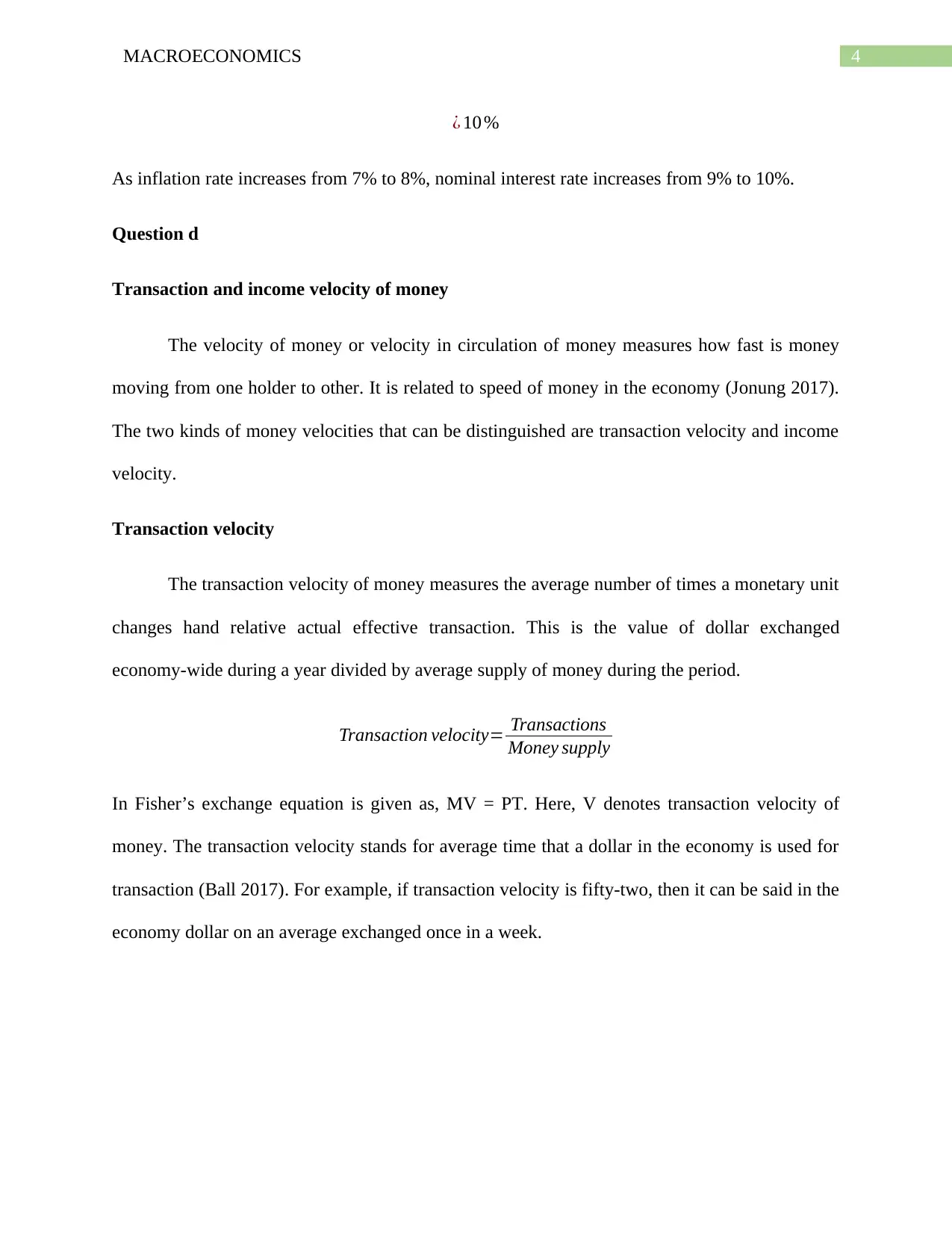
4MACROECONOMICS
¿ 10 %
As inflation rate increases from 7% to 8%, nominal interest rate increases from 9% to 10%.
Question d
Transaction and income velocity of money
The velocity of money or velocity in circulation of money measures how fast is money
moving from one holder to other. It is related to speed of money in the economy (Jonung 2017).
The two kinds of money velocities that can be distinguished are transaction velocity and income
velocity.
Transaction velocity
The transaction velocity of money measures the average number of times a monetary unit
changes hand relative actual effective transaction. This is the value of dollar exchanged
economy-wide during a year divided by average supply of money during the period.
Transaction velocity= Transactions
Money supply
In Fisher’s exchange equation is given as, MV = PT. Here, V denotes transaction velocity of
money. The transaction velocity stands for average time that a dollar in the economy is used for
transaction (Ball 2017). For example, if transaction velocity is fifty-two, then it can be said in the
economy dollar on an average exchanged once in a week.
¿ 10 %
As inflation rate increases from 7% to 8%, nominal interest rate increases from 9% to 10%.
Question d
Transaction and income velocity of money
The velocity of money or velocity in circulation of money measures how fast is money
moving from one holder to other. It is related to speed of money in the economy (Jonung 2017).
The two kinds of money velocities that can be distinguished are transaction velocity and income
velocity.
Transaction velocity
The transaction velocity of money measures the average number of times a monetary unit
changes hand relative actual effective transaction. This is the value of dollar exchanged
economy-wide during a year divided by average supply of money during the period.
Transaction velocity= Transactions
Money supply
In Fisher’s exchange equation is given as, MV = PT. Here, V denotes transaction velocity of
money. The transaction velocity stands for average time that a dollar in the economy is used for
transaction (Ball 2017). For example, if transaction velocity is fifty-two, then it can be said in the
economy dollar on an average exchanged once in a week.
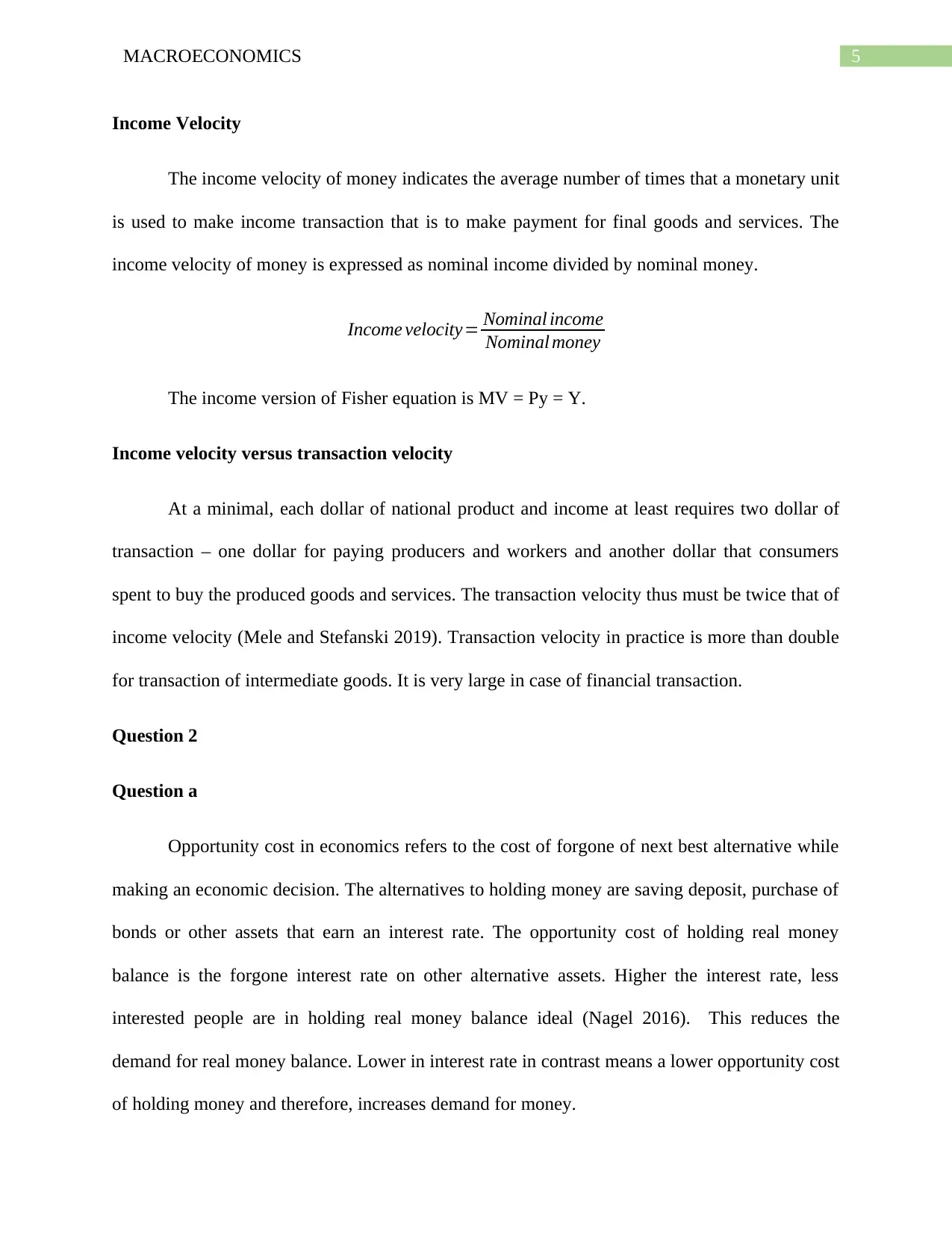
5MACROECONOMICS
Income Velocity
The income velocity of money indicates the average number of times that a monetary unit
is used to make income transaction that is to make payment for final goods and services. The
income velocity of money is expressed as nominal income divided by nominal money.
Income velocity= Nominal income
Nominal money
The income version of Fisher equation is MV = Py = Y.
Income velocity versus transaction velocity
At a minimal, each dollar of national product and income at least requires two dollar of
transaction – one dollar for paying producers and workers and another dollar that consumers
spent to buy the produced goods and services. The transaction velocity thus must be twice that of
income velocity (Mele and Stefanski 2019). Transaction velocity in practice is more than double
for transaction of intermediate goods. It is very large in case of financial transaction.
Question 2
Question a
Opportunity cost in economics refers to the cost of forgone of next best alternative while
making an economic decision. The alternatives to holding money are saving deposit, purchase of
bonds or other assets that earn an interest rate. The opportunity cost of holding real money
balance is the forgone interest rate on other alternative assets. Higher the interest rate, less
interested people are in holding real money balance ideal (Nagel 2016). This reduces the
demand for real money balance. Lower in interest rate in contrast means a lower opportunity cost
of holding money and therefore, increases demand for money.
Income Velocity
The income velocity of money indicates the average number of times that a monetary unit
is used to make income transaction that is to make payment for final goods and services. The
income velocity of money is expressed as nominal income divided by nominal money.
Income velocity= Nominal income
Nominal money
The income version of Fisher equation is MV = Py = Y.
Income velocity versus transaction velocity
At a minimal, each dollar of national product and income at least requires two dollar of
transaction – one dollar for paying producers and workers and another dollar that consumers
spent to buy the produced goods and services. The transaction velocity thus must be twice that of
income velocity (Mele and Stefanski 2019). Transaction velocity in practice is more than double
for transaction of intermediate goods. It is very large in case of financial transaction.
Question 2
Question a
Opportunity cost in economics refers to the cost of forgone of next best alternative while
making an economic decision. The alternatives to holding money are saving deposit, purchase of
bonds or other assets that earn an interest rate. The opportunity cost of holding real money
balance is the forgone interest rate on other alternative assets. Higher the interest rate, less
interested people are in holding real money balance ideal (Nagel 2016). This reduces the
demand for real money balance. Lower in interest rate in contrast means a lower opportunity cost
of holding money and therefore, increases demand for money.
⊘ This is a preview!⊘
Do you want full access?
Subscribe today to unlock all pages.

Trusted by 1+ million students worldwide
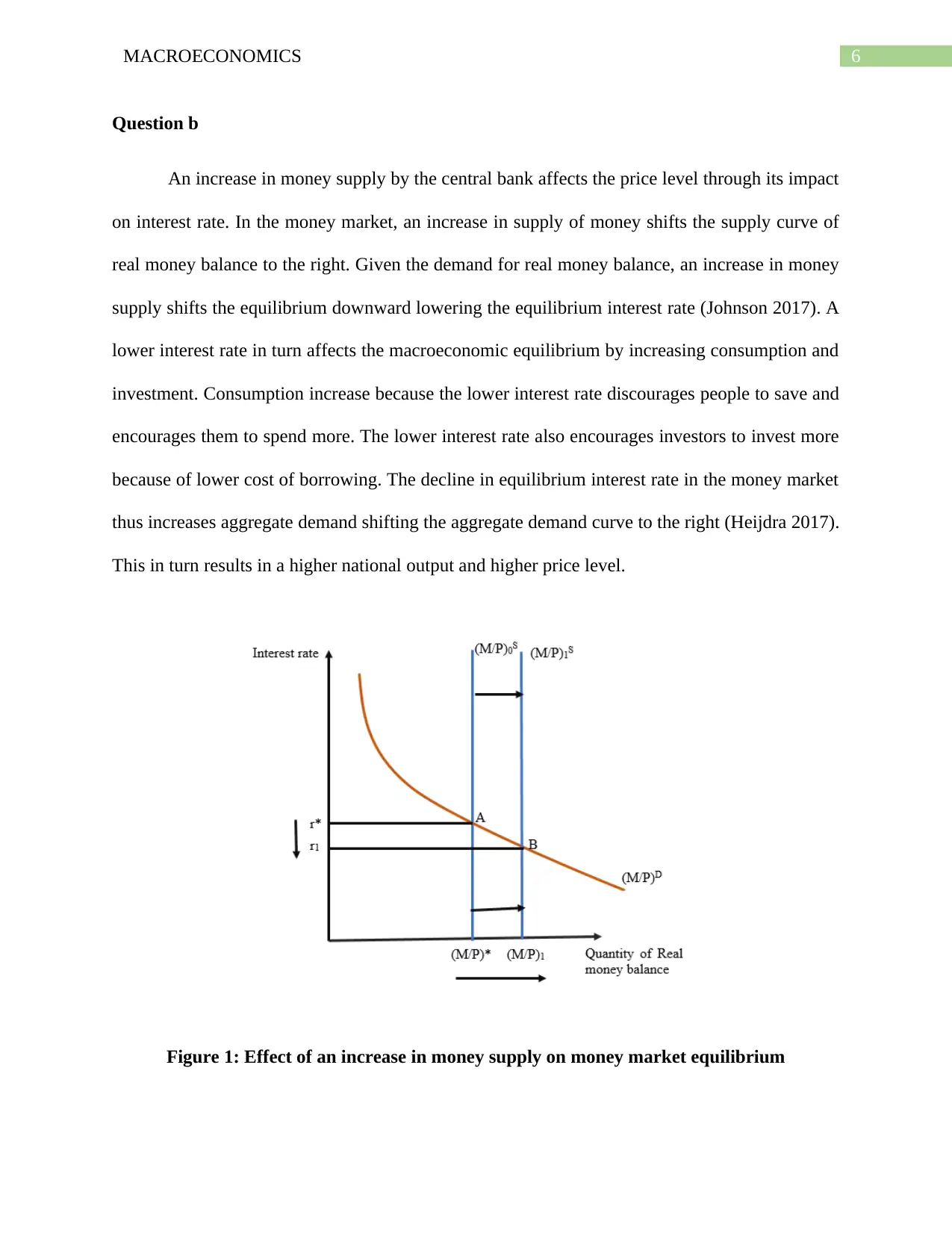
6MACROECONOMICS
Question b
An increase in money supply by the central bank affects the price level through its impact
on interest rate. In the money market, an increase in supply of money shifts the supply curve of
real money balance to the right. Given the demand for real money balance, an increase in money
supply shifts the equilibrium downward lowering the equilibrium interest rate (Johnson 2017). A
lower interest rate in turn affects the macroeconomic equilibrium by increasing consumption and
investment. Consumption increase because the lower interest rate discourages people to save and
encourages them to spend more. The lower interest rate also encourages investors to invest more
because of lower cost of borrowing. The decline in equilibrium interest rate in the money market
thus increases aggregate demand shifting the aggregate demand curve to the right (Heijdra 2017).
This in turn results in a higher national output and higher price level.
Figure 1: Effect of an increase in money supply on money market equilibrium
Question b
An increase in money supply by the central bank affects the price level through its impact
on interest rate. In the money market, an increase in supply of money shifts the supply curve of
real money balance to the right. Given the demand for real money balance, an increase in money
supply shifts the equilibrium downward lowering the equilibrium interest rate (Johnson 2017). A
lower interest rate in turn affects the macroeconomic equilibrium by increasing consumption and
investment. Consumption increase because the lower interest rate discourages people to save and
encourages them to spend more. The lower interest rate also encourages investors to invest more
because of lower cost of borrowing. The decline in equilibrium interest rate in the money market
thus increases aggregate demand shifting the aggregate demand curve to the right (Heijdra 2017).
This in turn results in a higher national output and higher price level.
Figure 1: Effect of an increase in money supply on money market equilibrium
Paraphrase This Document
Need a fresh take? Get an instant paraphrase of this document with our AI Paraphraser
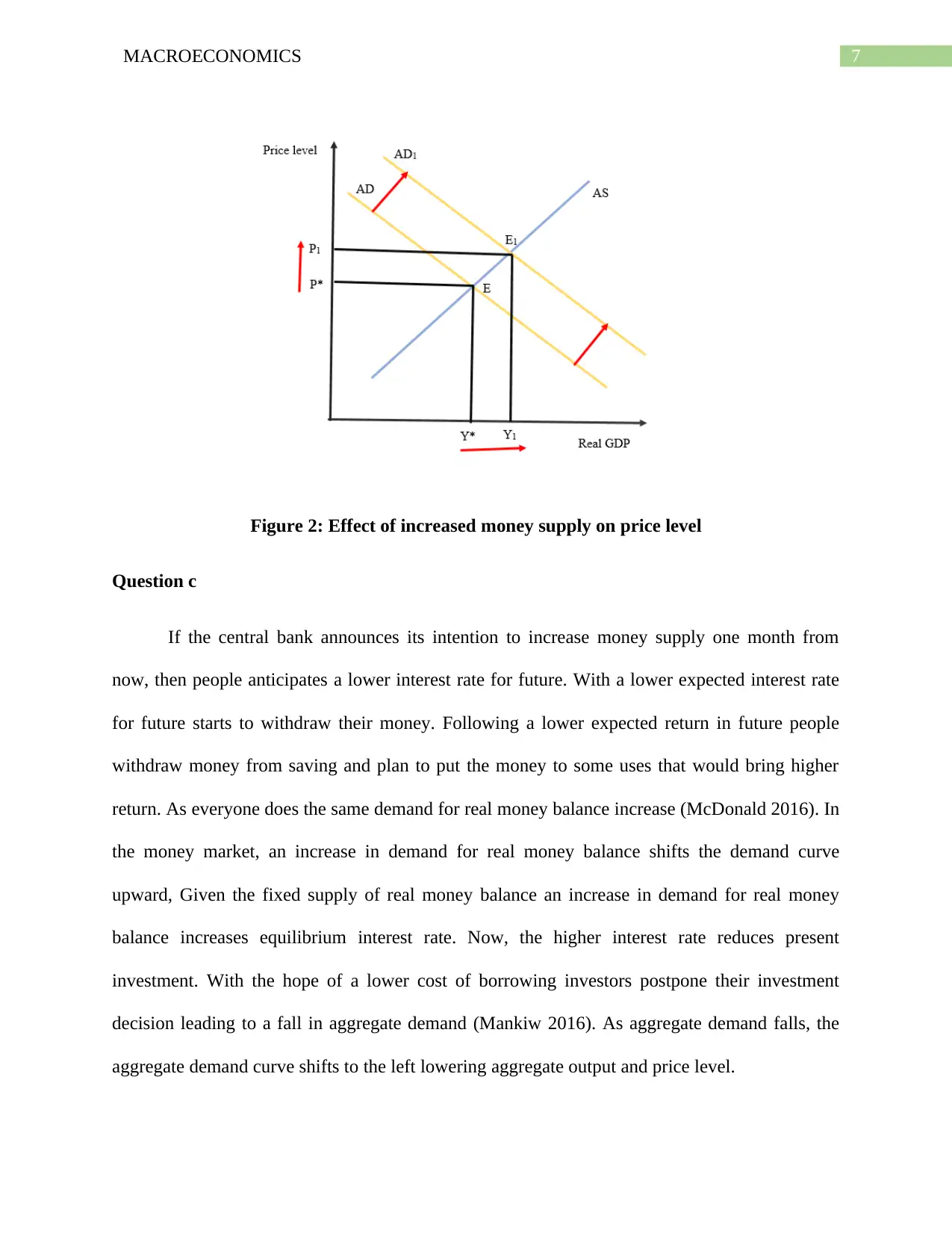
7MACROECONOMICS
Figure 2: Effect of increased money supply on price level
Question c
If the central bank announces its intention to increase money supply one month from
now, then people anticipates a lower interest rate for future. With a lower expected interest rate
for future starts to withdraw their money. Following a lower expected return in future people
withdraw money from saving and plan to put the money to some uses that would bring higher
return. As everyone does the same demand for real money balance increase (McDonald 2016). In
the money market, an increase in demand for real money balance shifts the demand curve
upward, Given the fixed supply of real money balance an increase in demand for real money
balance increases equilibrium interest rate. Now, the higher interest rate reduces present
investment. With the hope of a lower cost of borrowing investors postpone their investment
decision leading to a fall in aggregate demand (Mankiw 2016). As aggregate demand falls, the
aggregate demand curve shifts to the left lowering aggregate output and price level.
Figure 2: Effect of increased money supply on price level
Question c
If the central bank announces its intention to increase money supply one month from
now, then people anticipates a lower interest rate for future. With a lower expected interest rate
for future starts to withdraw their money. Following a lower expected return in future people
withdraw money from saving and plan to put the money to some uses that would bring higher
return. As everyone does the same demand for real money balance increase (McDonald 2016). In
the money market, an increase in demand for real money balance shifts the demand curve
upward, Given the fixed supply of real money balance an increase in demand for real money
balance increases equilibrium interest rate. Now, the higher interest rate reduces present
investment. With the hope of a lower cost of borrowing investors postpone their investment
decision leading to a fall in aggregate demand (Mankiw 2016). As aggregate demand falls, the
aggregate demand curve shifts to the left lowering aggregate output and price level.
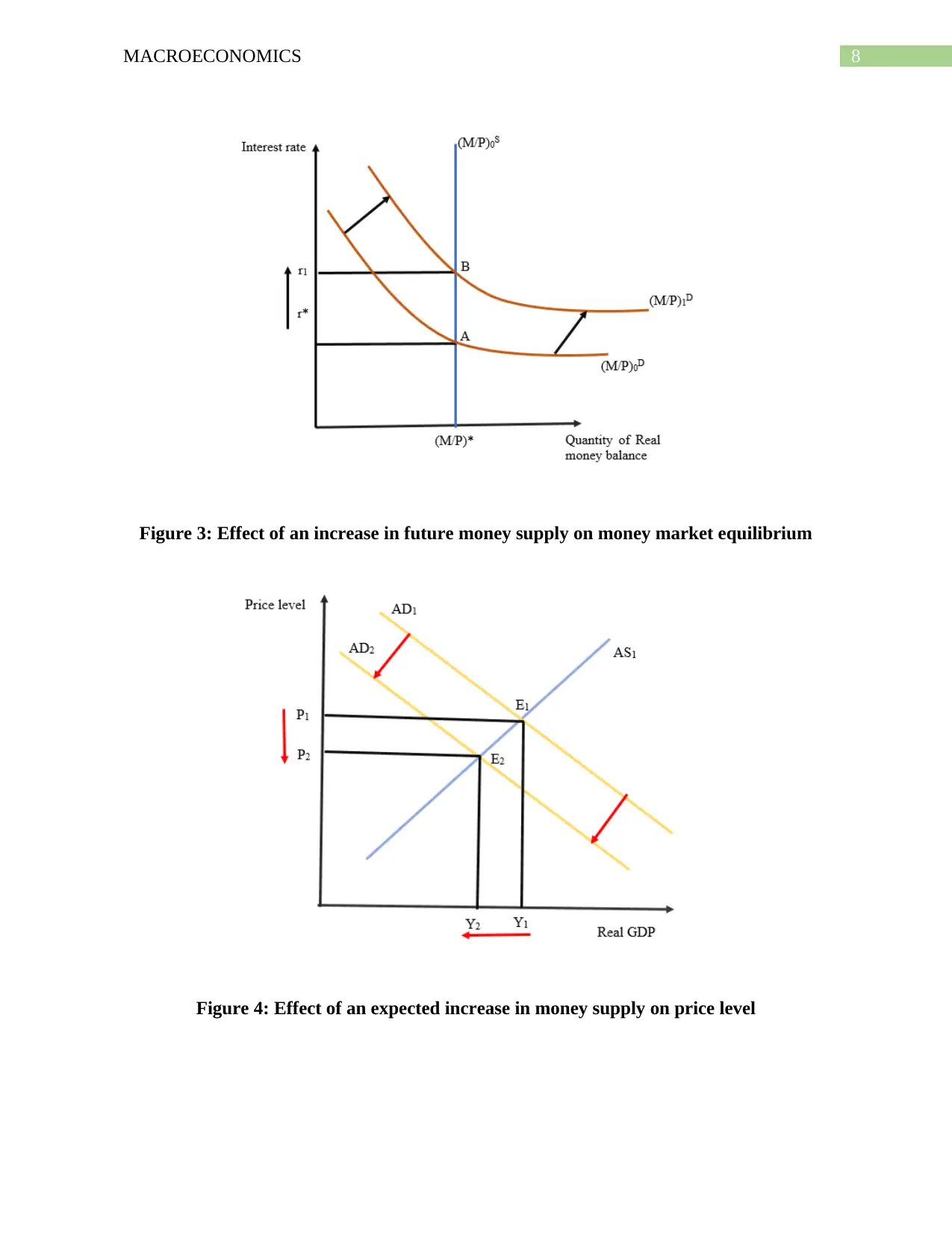
8MACROECONOMICS
Figure 3: Effect of an increase in future money supply on money market equilibrium
Figure 4: Effect of an expected increase in money supply on price level
Figure 3: Effect of an increase in future money supply on money market equilibrium
Figure 4: Effect of an expected increase in money supply on price level
⊘ This is a preview!⊘
Do you want full access?
Subscribe today to unlock all pages.

Trusted by 1+ million students worldwide
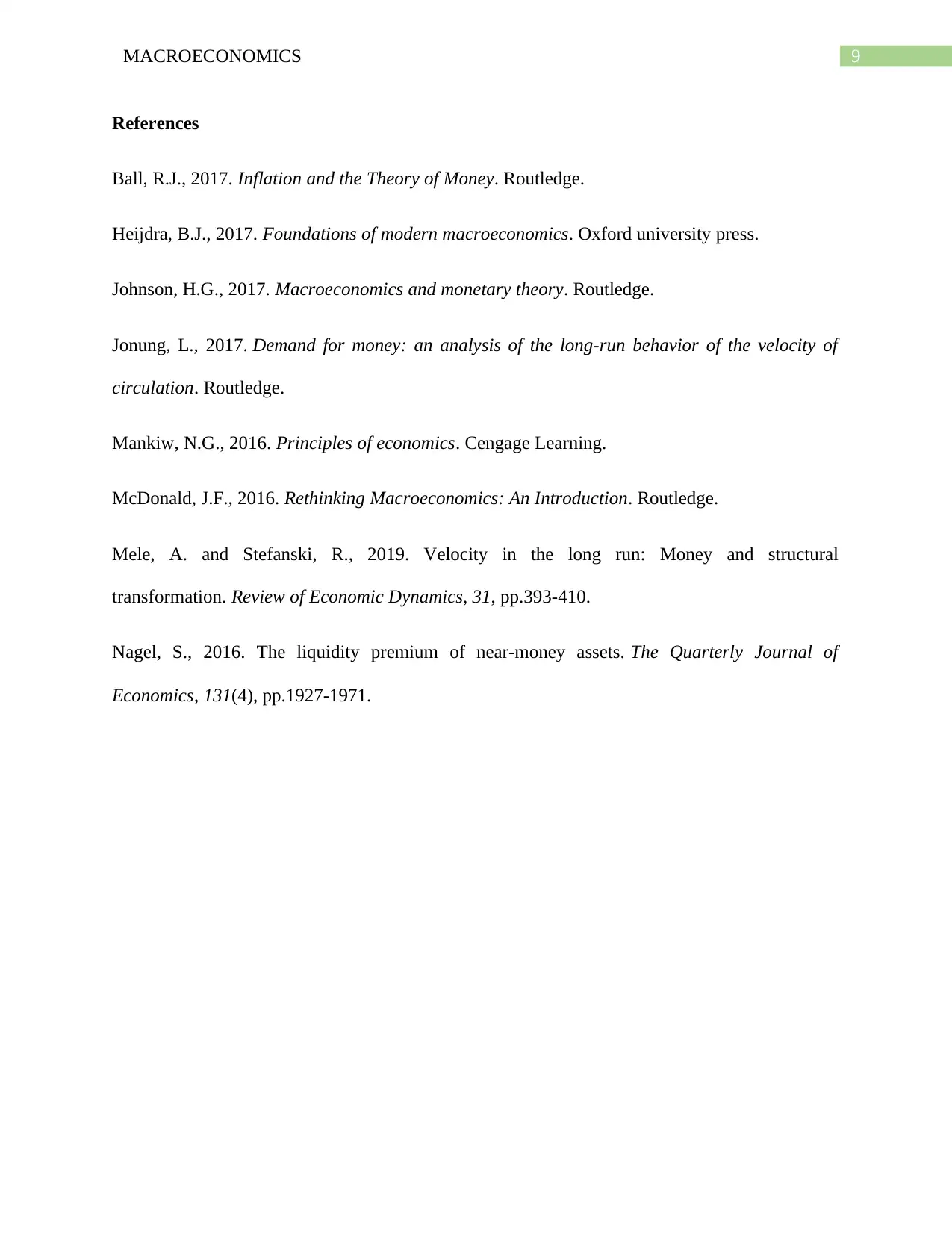
9MACROECONOMICS
References
Ball, R.J., 2017. Inflation and the Theory of Money. Routledge.
Heijdra, B.J., 2017. Foundations of modern macroeconomics. Oxford university press.
Johnson, H.G., 2017. Macroeconomics and monetary theory. Routledge.
Jonung, L., 2017. Demand for money: an analysis of the long-run behavior of the velocity of
circulation. Routledge.
Mankiw, N.G., 2016. Principles of economics. Cengage Learning.
McDonald, J.F., 2016. Rethinking Macroeconomics: An Introduction. Routledge.
Mele, A. and Stefanski, R., 2019. Velocity in the long run: Money and structural
transformation. Review of Economic Dynamics, 31, pp.393-410.
Nagel, S., 2016. The liquidity premium of near-money assets. The Quarterly Journal of
Economics, 131(4), pp.1927-1971.
References
Ball, R.J., 2017. Inflation and the Theory of Money. Routledge.
Heijdra, B.J., 2017. Foundations of modern macroeconomics. Oxford university press.
Johnson, H.G., 2017. Macroeconomics and monetary theory. Routledge.
Jonung, L., 2017. Demand for money: an analysis of the long-run behavior of the velocity of
circulation. Routledge.
Mankiw, N.G., 2016. Principles of economics. Cengage Learning.
McDonald, J.F., 2016. Rethinking Macroeconomics: An Introduction. Routledge.
Mele, A. and Stefanski, R., 2019. Velocity in the long run: Money and structural
transformation. Review of Economic Dynamics, 31, pp.393-410.
Nagel, S., 2016. The liquidity premium of near-money assets. The Quarterly Journal of
Economics, 131(4), pp.1927-1971.
1 out of 10
Related Documents
Your All-in-One AI-Powered Toolkit for Academic Success.
+13062052269
info@desklib.com
Available 24*7 on WhatsApp / Email
![[object Object]](/_next/static/media/star-bottom.7253800d.svg)
Unlock your academic potential
Copyright © 2020–2025 A2Z Services. All Rights Reserved. Developed and managed by ZUCOL.





